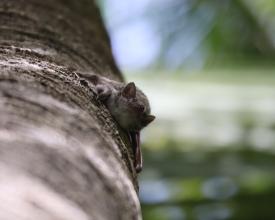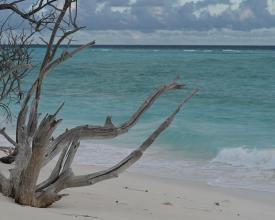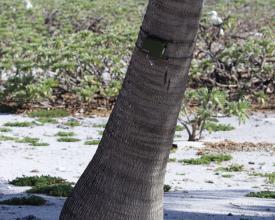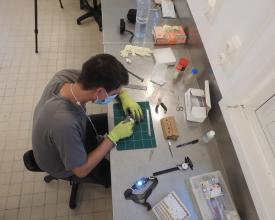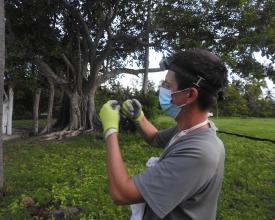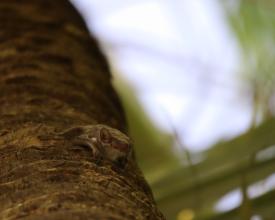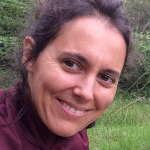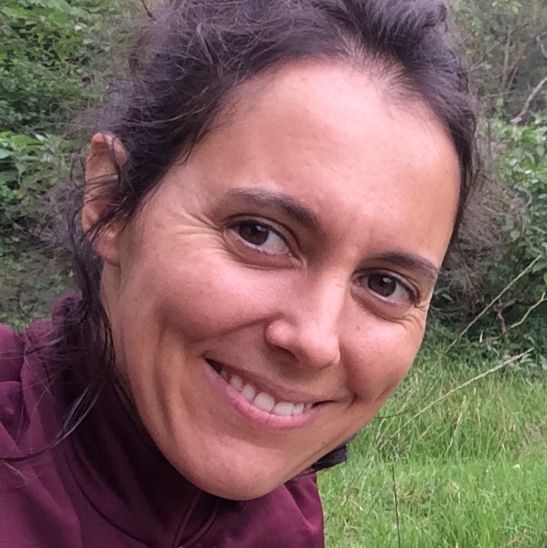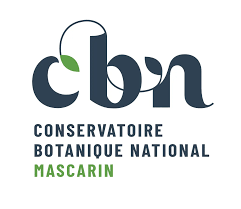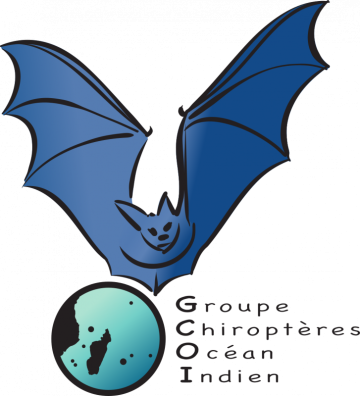
Chiropt'îles project: Inventory of chiropteran communities in the Eparses Islands belonging to the French Southern and Antarctic Lands (Terres Australes et Antarctiques Françaises)
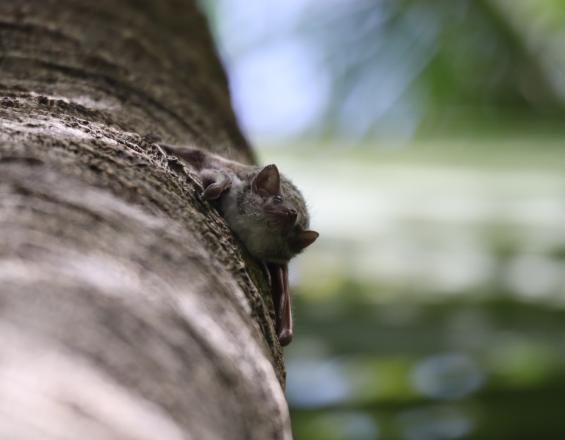
As part of a Best 2.0+ project funded by the European Commission and led by the Groupe Chiroptères Océan Indien in partnership with the Terres Australes et Antarctiques Françaises, a study of the chiropteran communities present on 3 of the Éparses islands has been carried out with the aim of acquiring the knowledge necessary for their conservation.
An initial field phase, based on the proven presence of the MauritiusTaphozous (Taphozous mauritianus), was carried out on Grande Glorieuse, complemented by a passive acoustic survey carried out on the islands of Tromelin, Europa and Grande Glorieuse.
The results show that two species of chiropteran were identified on Grande Glorieuse, unlike on Europa and Tromelin, where no bats were found. Based on these results, recommendations for monitoring, management and awareness-raising have been drawn up for each of the islands.
Context
Challenges addressed
-
Carry out the first inventory of chiropterans potentially present in the Eparses Islands.
-
Improve knowledge of the ecology and land use of the Mauritius taphids present on Grande Glorieuse.
-
Train TAAF agents in the deployment of passive recorders
-
Discover an undetermined bat species on Grande Glorieuse
-
Prove the absence of chiropterans on Tromelin
-
Collect genetic samples of Taphiens individuals from Mauritius to Grande Glorieuse to improve knowledge of its range
-
Demonstrate that the Taphiens de Maurice population on Grande Glorieuse is reproductive.
-
Establish management recommendations in line with local chiropteran issues for each of the islands.
-
Consider a follow-up project on Europa, Grande Glorieuse and Juan de Nova.
Location
Process
Summary of the process
This project is based on close collaboration with the TAAF. Indeed, the implementation of the various protocols would not have been possible without the coordinator of the conservation programs for the terrestrial ecosystems of the Eparses Islands, the logistics manager, or the TAAF field agents. What's more, the various protocols put in place are complementary, as they all provide previously unpublished information, all with the aim of acquiring the knowledge necessary for the TAAF's conservation of the bat species present on three of the Eparses islands.
Building Blocks
The Eparses Islands, a unique study area
Since 2005, the TAAF has managed the Éparses islands, comprising the Glorieuses archipelago, Juan de Nova, Tromelin, Europa and Bassas de India. Most of these islands are located in the Mozambique Channel, with the exception of Tromelin, north of Reunion Island.
Despite a small total land area (43 km²), the total waters under French jurisdiction linked to these islands represent 6% of French maritime territory.
These islands are part of the Madagascar and Indian Ocean Islands Biodiversity Hotspot, a regionally recognized natural heritage; they are included in 4 of the 320 Ecologically and Biologically Significant Marine Areas identified by the Convention on Biological Diversity; they are recognized as Key Biodiversity Areas by the IUCN; and some are recognized as Important Bird Areas by BirdLife International.
Despite the permanent presence of TAAF environmental officers on these islands, no studies had been carried out on chiropterans prior to the Chiropt'îles project. Only a few mentions of bats (genus Mops sp, Taphien de Maurice) have been recorded on the islands of Grande Glorieuse, Europa and Juan de Nova.
Enabling factors
- Establishment of a partnership between GCOI and TAAF
- Definition of project objectives in consultation with TAAF and MNHN
- Collection of previous records of bats in the Eparses Islands
- Definition of protocols to be implemented, adaptable to each island studied and to logistical resources
Lesson learned
- Improving knowledge of biodiversity on the islands of Tromelin, Grande Glorieuse and Europa
- First partnership between TAAF and GCOI
- Opportunity to communicate the results of the study
Passive acoustic listening protocol
On each island concerned by the project, 2 SongMeter mini bat ultrasonic recorders were deployed during 2 listening sessions by 7 agents from the Terres australes et antarctiques françaises, previously trained by the GCOI in their use. The two listening sessions took place in winter (December-January) and austral summer (July-August), based on knowledge of the Taphien of Mauritius. Positioned for 5 nights, in 4 pre-selected habitat types, 20 listening nights per recorder and per session were recorded. In all, 240 listening nights were recorded on all the islands.
Sampling plans were based on data on the different types of environment present on the three islands, supplied by the Conservatoire Botanique National de Mascarin.
Once the recordings had been retrieved, the data were processed using a fixed-point protocol derived from the VigieChiro system managed by the Muséum National d'Histoire Naturelle in Paris, enabling the chiropteran species recorded in the sound files to be determined. Once the sounds had been processed automatically, a manual acoustic analysis was carried out by GCOI employees to identify any species not detected by the software.
Enabling factors
-
Training of TAAF agents by the GCOI in the use of recorders
-
Involvement and autonomy of TAAF agents in setting up the protocol
-
Cooperation with CBNM to provide data on the types of environment on each island studied.
-
Cooperation with MNHN to adapt the fixed-point protocol to a study area other than metropolitan France
-
Involvement of GCOI employees in sound processing and analysis, and in drawing up management recommendations adapted to the results of the study.
Lesson learned
-
Presence of two chiropteran species on Grande Glorieuse
-
No chiropterans on Tromelin
-
Doubt as to the presence or absence of chiropterans on Europa
-
Good partnerships with TAAF, CBNM and MNHN
Field mission to Grande Glorieuse
During a 14-day field mission on the island of Grande Glorieuse, the GCOI's scientific coordinator deployed three different scientific protocols aimed at improving knowledge of the island's potential chiropteran species, and in particular of the Mauritian Taphien, whose presence has been confirmed.
The first phase involved active acoustic transects across the entire island, to identify areas frequented by the Mauritius Taphenid and any other bat species. Based on the results of this listening, visual surveys were carried out in frequented areas (notably coconut groves) to identify roosting areas and assess the numbers of the Mauritius Taphenid population. Capture sessions were then carried out in these roosting areas to collect genetic samples from the Mauritius taphid individuals captured. Subsequent genetic studies will be carried out on these samples, in partnership with PIMIT, to improve our knowledge of the species' biogeographical distribution and assess the potential role of Grande Glorieuse in this.
Enabling factors
-
Have obtained authorization to access Grande Glorieuse via a scientific campaign
-
To have obtained a place for a round trip on the FAZSOI's means of transport
-
Have provided a complete and correct medical file from the operator to the TAAF
-
Have been able to adapt to the logistical constraints imposed by the FAZSOI to carry out rotations to and from the Eparses Islands
-
Adapted to the island's meteorological constraints and, despite this, met all the planned objectives.
-
Established a partnership with PIMIT
Lesson learned
-
Census of the Taphien de Maurice only, by active listening
-
Identification of areas frequented by the Taphien de Maurice
-
Identification of an area used by the Taphien de Maurice (on the base, in a coconut grove with 209 coconut trees).
-
Estimated population size at 10 individuals, including a non-flying juvenile
-
Discovery that the Mauritius Taphenid population is breeding on the island.
-
Capture of 9 individuals, 7 different, 4 females and 3 males
-
Collection of 7 genetic, salivary and faecal samples for subsequent analysis
-
Biometric measurements taken on all captured individuals
-
Future genetic analyses to provide information on the global range of the Mauritius Taphenid.
Monitoring and management recommendations
Based on the results of the various protocols implemented in the Chriopt'îles project, management recommendations were formulated by the GCOI and presented to the TAAF, managers of the Eparses Islands.
Based on acoustic analyses and the hostile environment on Tromelin, the island does not appear to be home to any chiropteran species. No recommendations for management or further study are envisaged.
Despite the absence of chiropteran sounds in Europa's acoustic analyses, its history and local context suggest that chiropterans could still be present. It is planned to re-deploy the passive listening protocol over periods based on the dates of historical observations. Management recommendations will be made following this research.
2 species of chiropteran have been recorded on Grande Glorieuse, including the Taphien de Maurice and an undetermined species. The renewal of the passive acoustic protocol is envisaged in order to improve knowledge of the occupation of the territory by these species. Monthly visual monitoring of the coconut grove at the life base is also envisaged. The management of invasive exotic species on Filaos or Coconut trees must take into account the presence of these two species.
Enabling factors
-
Obtain representative results from the various protocols implemented
-
Organization of a meeting during the project with the TAAF to discuss feasibility, technical, logistical and human constraints relating to the recommendations.
-
Organization of a feedback meeting with the Prefect of the TAAF, Mrs. Florence JEANBLANC-RISLER, to present the established recommendations.
-
TAAF welcomed and approved the management recommendations.
-
Willingness of both parties (GCOI and TAAF) to continue the partnership by considering a follow-up to the project.
Lesson learned
-
Establishment of a working partnership between GCOI and TAAF
-
Development of management recommendations for each of the islands studied, based on the overall results of the project.
-
Willingness to pursue the acquisition of knowledge concerning the chiropteran assemblages present in the Eparses islands.
Impacts
A passive listening protocol was deployed on the islands of Grande Glorieuse, Europa and Tromelin in 2022 to carry out the first inventory of bats present on these territories. The protocol involved the installation of passive ultrasonic recorders in summer and southern winter, for a total of 80 nights of listening on each island. No species were identified on either Europa or Tromelin. However, two species of chiropteran were recorded on Grande Glorieuse: the Mauritius Taphozous (Taphozous mauritianus) and a species that remains undetermined.
To complement this inventory, GCOI's scientific coordinator carried out a 14-day mission on Grande Glorieuse in March 2022, during which active acoustic transects with an ultrasonic detector were used to identify areas frequented by bats. Visual surveys were then carried out on 209 coconut trees to identify roosting areas and estimate the size of the Mauritius Taphien population at 10 individuals, including a non-flying juvenile, showing that the species is breeding on the island. During capture sessions, genetic samples were taken from 7 different individuals (4 females and 3 males) to improve knowledge of the species' biogeographical distribution.
Beneficiaries
The main beneficiaries are the Terres Australes et Antarctiques Françaises, the Muséum National d'Histoire Naturelle and the scientific community involved in the study of chiropterans.
Sustainable Development Goals
Story
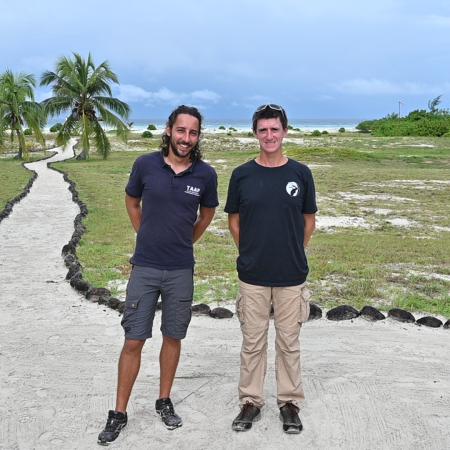
The field mission to the island of Grande Glorieuse was an atypical experience for the GCOI's scientific coordinator. Grande Glorieuse is an isolated island in the Indian Ocean, north of the Mozambique Channel, 253 km northeast of Mayotte and 222 km from Nosy-Be in Madagascar. Only a team of 14 military personnel, 1 gendarme and 1 environmental officer from the TAAF (French Southern and Antarctic Lands) are present on a continuous basis, with teams rotating every 45 days or so. The teams are then flown to the island by FAZSOI (Forces armées de la Zone Sud Océan Indien) aircraft, requiring a complex logistical organization to which the scientific coordinator has had to adapt (limited on-board weight including equipment (personal and scientific) and field operator), flight dates that can be changed at the last minute according to FAZSOI constraints).
Several other aspects of the mission also called for adaptation solutions. Weather conditions were difficult (lots of rain in March 2022), complicating the management of capture equipment (compulsory drying at the end of each capture session), its set-up and the execution of captures. The capture protocol also had to be adapted to the behavior of Taphien de Maurice individuals, which were not so easy to capture. Captures are usually made in the evening, but the individuals adopted avoidance behaviours which meant that the capture devices had to be set up at half-mast during the day, only to be opened once night had set in and the bats had flown away. In this way, the device was not spotted by the bats, thus limiting their avoidance behaviour.
Despite these various limitations, the objectives of this field mission were amply met, and the links that the coordinator was able to forge with the rest of the team on site were very interesting from both a professional and a personal point of view.

